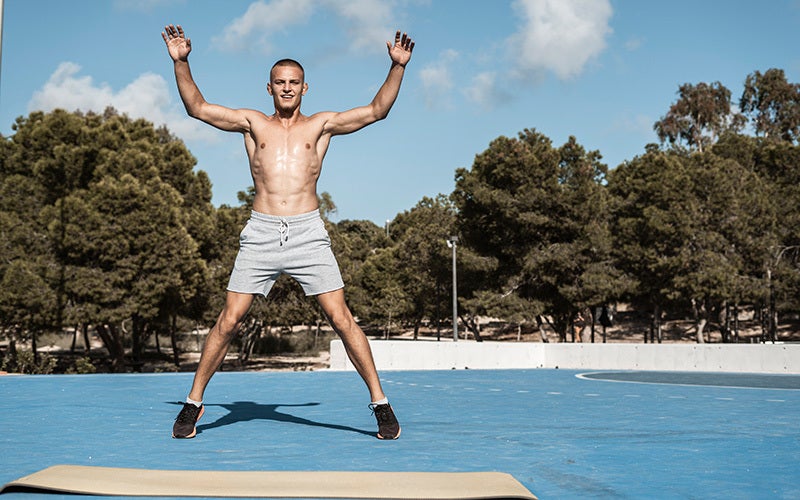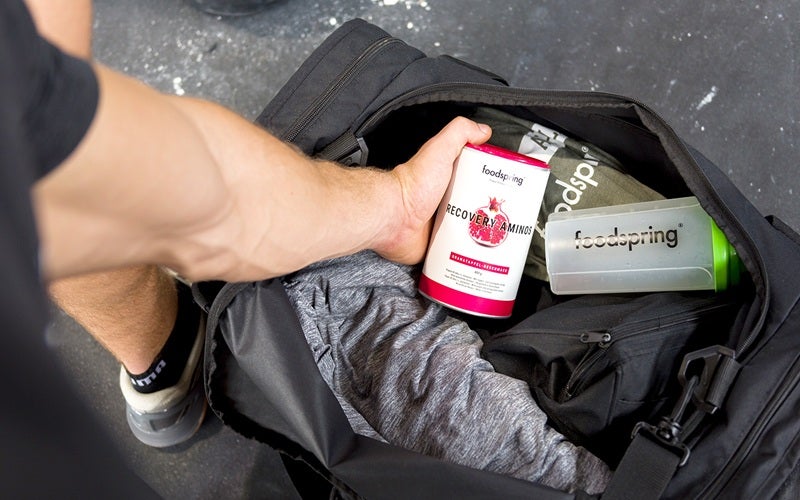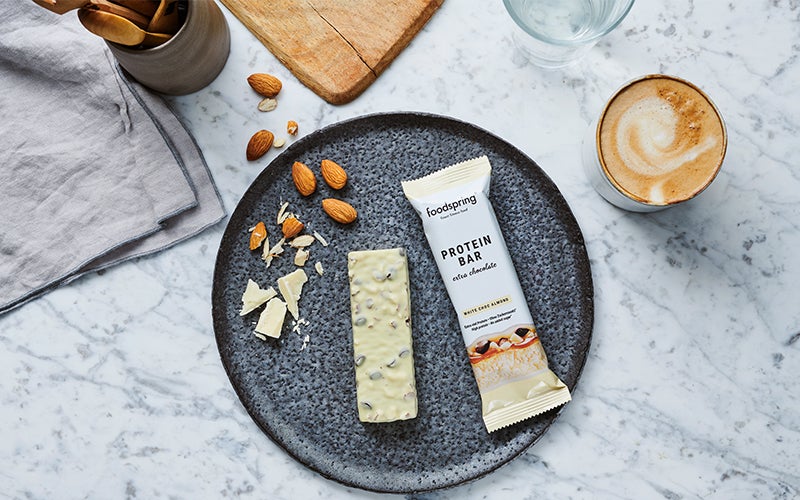Why You Need to Warm Up and How to Do It
 ©Westend61
©Westend61
A good warm-up can improve our ability to perform, provided you’re adapting it to your workout and paying attention to when you do it. Here, we break down everything you need to know to warm up well. Bonus: free exercises to warm up for the gym and at home.
What is a warm-up?
This term encompasses the small movements we do at moderate intensity to raise our body temperature. A good warm-up program uses as many muscle groups as possible and activates the cardiovascular system. The goal is to stimulate blood circulation, which enables your muscles to obtain more oxygen and nutrients so they can perform better. It gets you ready for a workout both physically and mentally, so that you can get the most out of it.
There are two types of warm-ups: general, which activates the whole body and doesn’t depend on the type of workout you’re doing; and targeted, which prepares an athlete for the specific needs related to their discipline.
| General | Targeted | |
| Objective | Increased heart rate and activation of all your muscles. | Stretching and strengthening certain muscle groups and improving coordination. |
| Examples of workouts | Walking at a pleasant pace, jogging, rowing, or skipping rope, weight-lifting exercises such as jumping jack or knee lifts and dynamic stretching. | Basics of running, step and punch sequences, static stretching, mobility training, exercises with foam rollers or resistance bands. |
How important is warming up?
In order to save time, many athletes skip their warm-ups. Is there a risk of injury or is warming up overrated?
Some can simply put on their sneakers and be ready to go! Even if that’s true for you, one thing’s for sure: warming up prepares your joints, muscles, and blood circulation for the effort involved in working out. It also increases your ability to concentrate and keeps you mentally prepared when it’s time to make the effort.
If you start exercising without warming up, or even right after getting up in the morning, your performance may suffer: It will take you longer to run, even at a moderate pace, you’ll react more slowly, and your range of motion will be more limited. A targeted warm-up before a strength training session can, for example, help you squat deeper and even perform full pull-ups. In combat sports, when warmed up, you are more likely to deliver stronger blows and have quicker reflexes.

Whether or not a warm-up reduces your risk of injury is still hotly debated. Studies on this subject show numerous different results¹. However, some indicate that doing it can significantly improve performance² provided that it does not overtax the body and does not make it more vulnerable to injury.
What happens to the body during a warm-up?
Cardiovascular System:
When you’re warming up, you’re straining your body more than when you’re resting. Your temperature rises and you begin to breath more intensely. Your heart has to beat faster to supply all the organs with enough nutrients, which in turn supplies you with necessary energy for your workout.
Your heart rate should increase slowly and steadily, and will ideally be at a level between 50 and 90% of your maximum heart rate.
Muscles:
A warm-up increases blood flow to the muscles and provides them with oxygen and nutrients they need to perform well during a workout. This also enables them to regenerate faster.
Our tip: You can support your recovery period by eating a diet rich in protein and carbohydrates. It’s also crucial to get an adequate supply of essential amino acids. Our Recovery Aminos make it easy to get what you need after every training session. They’re a great way to recharge your muscles and so you’re ready for the next workout.

Joints:
Mobilizing your joints, the middle layer, the cartilage, gently compresses and relaxes the middle layer of cartilage. The body then produces more synovial fluid—the fluid that lubricates the joints and prevents friction. As a result, the cartilage layer becomes thicker and better able to absorb shocks. It also enables a better range of motion. You can prevent joint pain and injuries by warming them up regularly.
Nerves:
A warm-up speeds up all the body’s metabolic processes. It also increases the sensitivity of nerve pathways. Synapses can perceive and transmit stimuli more quickly. The speed at which you react is also faster, meaning you’re not only more physically powerful but mentally quick, too.
Which warm-up is right for which workout?
You need to adapt your pre-workout plan to the type of workout you’re doing. If you strain your body too much before the workout, you’re at a higher risk of injury during it.
| Sport | Warm-up |
| Running | running at a moderate pace, basics of running, light static stretching |
| Strength training | Mobility training or dynamic stretching, rowing, training sequences with or without light weights, exercises with resistance bands |
| Combat sports | Punching and kicking sequence, jumping rope |
| Ball sports | Mobility training or static stretching, gentle endurance training, exercises with resistance bands |
| Yoga | Soft static stretch |
How long should a warm-up take?
Exactly how long you need to be is hard to pin down. It can vary depending on age, activity level, type of workout, and outdoor temperature. For example, if you are going on an outdoor run, it will take more time to heat your body up in winter than in the middle of summer (when it’s already hot).
Studies have shown that they should ideally take between 10 and 15 minutes³. You should increase the intensity gradually. And your heart rate should be between 50 and 90% of your maximum heart rate.
Warming up at the gym
Here’s what your pre-workout plan at the gym might look like:
- 5 minutes of general stretching and exercises at moderate intensity (about 70% of your maximum heart rate).
- 5 to 10 minutes of targeted low-intensity stretches and exercises.
Before working out on a cardio machine, warm-up exercises are always recommended. Here are some of the machines you might find:
- Treadmill
- Elliptical
- Rowing
- Stationary bike
- Pro Ski-Simulator
- Assault air bike
Weight-bearing exercises are also excellent for stimulating blood circulation. Here are some examples:
- Jumping jacks
- Shadow-boxing
- Knee lifts
- Mountain climbers
- Jumping rope
During targeted warm-ups, it’s important to focus on the muscle groups you plan to use while exercising. Most importantly, never forget your core. You’ll use your core in most workouts, so it must always be active and should be warmed up accordingly before you begin.
Stretching exercises, as well as circular movements that mobilize your muscles, are also ideal.
Here are some exercises you can do with your own body weight:
- Torso twist while standing
- Lunges with upper body twist
- Front bends with upper body twist
- Arm circles
- Hip circles
- Superman planks
- Downward dog position transitioning to plank
- World’s Greatest Stretch
At the gym, you usually have plenty of tools to choose from, such as foam rollers, resistance bands, cable pulleys and gym balls.
Above all else, it’s essential to warm up the muscles and mobilize the joints, but not to put too much stress on the body. After all, you ideally want to have enough strength for your workout without risking injury.
At-home warm up session
We’ve concocted a 10-minute warm-up session for you, without equipment, that you can do at home.
| Exercise | Length |
| Running in place | 1 minute |
| Jumping jacks | 1 minute |
| Shadow-boxing with quick steps in place | 30 seconds |
| Running in place | 1 minute |
| Forward circular arm movements | 30 seconds |
| Backwards circular arm movements | 30 seconds |
| Circular hip movement | 30 seconds |
| Air Squats | 30 seconds |
| Jumping squats | 30 seconds |
| Jumping jacks | 1 minute |
| Lunges with torso twist | 1 minute |
| Arm and leg lifts in a crawling position | 1 minute |
| Mountain climbers | 1 minute |
What are the benefits of an active recovery?
While warming up gets your cardiovascular system going and raises your internal temperature, an active recovery or “cool down” brings you back down to earth. After an intense strength or endurance workout, the body cools down.
There are two steps to a cool down:
- Active recovery: By doing moderate intensity exercises and stretches directly after your workout, you stabilize your cardiovascular system. After exercise, your heart rate will return to a normal level and you’ll be able to breathe deeply again.
- Muscle regeneration: Relaxing movements help you to relax physically and mentally and promote faster removal of metabolic waste products.
Make sure your recovery is conscious and moderate, taking care not to overwork your muscles. If you work out too hard during recovery, you could prevent muscle regeneration.
An after-workout snack is even more important than relaxing. It gives your muscles the nutrients and energy they need and to regenerate. Our Whey Protein is a quick and easy way to give your post-training shake a boost. And our Extra Chocolate Protein Bar (available in five delicious chocolate varieties) is even more satisfying.
©GCaptureTry our extra chocolate Protein Bar
Warming up: Our conclusion
- A warm-up raises the body temperature, stimulates the cardiovascular system, and promotes blood circulation. The muscles receive important nutrients and energy.
- Warming up enables you to prepare mentally for the effort ahead.
- Studies show that they can improve performance during a workout.
- There’s a difference between a general warm-up, which is intended to speed up the heart rate, and a targeted warm-up, which consists of exercises adapted to the particular activity.
- An optimal program lasts between 10 and 15 minutes and is performed at a moderate intensity between 50 and 90% of the maximum heart rate.
Sources for this article
We at foodspring use only high-quality sources, including peer-reviewed studies, to support the facts within our articles. Read our editorial policy to learn more about how we fact-check and keep our content accurate, reliable, and trustworthy.






























